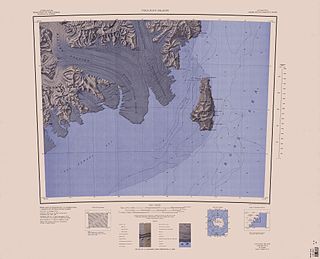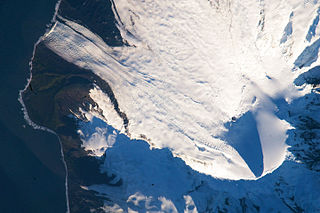Related Research Articles

Borchgrevink Glacier is a large glacier in the Victory Mountains, Victoria Land, draining south between Malta Plateau and Daniell Peninsula, and thence projecting into Glacier Strait, Ross Sea, as a floating glacier tongue, the Borchgrevink Glacier Tongue, just south of Cape Jones. It was named by the New Zealand Geological Survey Antarctic Expedition, 1957–58, for Carsten Borchgrevink, leader of the British Antarctic Expedition, 1898–1900. Borchgrevink visited the area in February 1900 and first observed the seaward portion of the glacier.

Jacka Glacier is a 0.8-mile (1.3 km) long glacier which flows northeast from Hayter Peak and terminates in icefalls opposite Vanhoffen Bluff on the north side of Heard Island in the southern Indian Ocean. The glacier appears to be roughly charted on an 1860 sketch map compiled by Captain H.C. Chester, an American sealer operating in the area during this period. It was surveyed in 1948 by the Australian National Antarctic Research Expeditions, and named by them for Fred J. Jacka, an expedition physicist.
Gilchrist Beach is a rocky beach, 1 nautical mile (1.9 km) long, lying west of Compton Glacier on the north side of Heard Island. At its eastern edge, Gilchrist Beach communicates with the sandy Fairchild Beach. Travelling eastwards from Gilchrist Beach to Fairchild Beach, one arrives at the base of Round Hill.

Baudissin Glacier is a tidewater glacier on the north side of Heard Island. in the southern Indian Ocean. Located 1 nautical mile (1.9 km) west of Challenger Glacier, Baudissin Glacier is 1.5 nautical miles (2.8 km) wide and flows into the western part of Corinthian Bay. The terminus of Baudissin Glacier is located at the western side of Corinthian Bay, at Sealers Cove. To the east of Baudissin Glacier is Challenger Glacier, whose terminus is located at the eastern side of Corinthian Bay, close west to Saddle Point. To the south of Baudissin Glacier is Schmidt Glacier, and to the northwest is Atlas Cove. Kildalkey Head is west of Schmidt Glacier. To the south of Schmidt Glacier is Vahsel Glacier, whose terminus is at South West Bay, between Erratic Point and Cape Gazert. Immediately south of Vahsel Glacier is Allison Glacier. Click here to see a map of Baudissin Glacier and the northwestern coast of Heard Island.

Cape Arkona is a rocky headland between the mouths of Lied Glacier and Gotley Glacier on the southwest side of Heard Island in the southern Indian Ocean. The feature appears to be roughly charted on an 1860 sketch map prepared by Captain H.C. Chester, an American sealer operating in the area during this period. The German frigate Arkona examined the south coast of the island in February 1874 and, in Melbourne, provided the officers of HMS Challenger with a position for the cape which was used in preparation of the Admiralty chart. In so doing, however, the misspelling "Cape Arcona" was used on the British chart.

Stephenson Glacier is a glacier close west of Dovers Moraine on the east side of Heard Island in the southern Indian Ocean. Its terminus is between Dovers Moraine and Stephenson Lagoon, with part of the glacier flowing to Doppler Hill and Sealers Beach. To the north of Stephenson Glacier is Brown Glacier, whose terminus is located at Brown Lagoon. To the southwest of Stephenson Glacier is Winston Glacier, whose terminus is located at Winston Lagoon, between Cape Lockyer and Oatt Rocks.

Deacock Glacier is a glacier close west of Lavett Bluff on the south side of Heard Island in the southern Indian Ocean. Its terminus is between Cape Labuan and Long Beach. To the east of Deacock Glacier is Fiftyone Glacier, whose terminus is located between Lavett Bluff and Lambeth Bluff. To the west of Deacock Glacier is Gotley Glacier, whose terminus is located between Cape Arkona and Cape Labuan.

Downes Glacier is a broad tidewater glacier on the north side of Heard Island in the southern Indian Ocean. It flows north on both sides of Cape Bidlingmaier to the north coast of Heard Island. To the east of Downes Glacier is Ealey Glacier, whose terminus is located close southeast of Cape Bidlingmaier. To the west of Downes Glacier is Challenger Glacier, whose terminus is located at the eastern side of Corinthian Bay, close west to Saddle Point. Saddle Point separates Downes Glacier from Challenger Glacier.

Vahsel Glacier is a glacier on the northwestern side of Heard Island in the southern Indian Ocean. It flows west into South West Bay, between Erratic Point and Cape Gazert. Immediately to the north of Vahsel Glacier is Schmidt Glacier, whose terminus is located between Mount Drygalski and North West Cornice. To the south of Vahsel Glacier is Allison Glacier, whose terminus is located south of Cape Gazert, which separates Allison Glacier from Vahsel Glacier.

Schmidt Glacier is a glacier, 0.7 nautical miles (1.3 km) long, flowing west from Baudissin Glacier between Mount Drygalski and North West Cornice, on the west side of Heard Island in the southern Indian Ocean. To the north of Schmidt Glacier is Baudissin Glacier, whose terminus is located at the western side of Corinthian Bay, near Sealers Cove. Kildalkey Head is west of Schmidt Glacier. To the south of Schmidt Glacier is Vahsel Glacier, whose terminus is at South West Bay, between Erratic Point and Cape Gazert. Immediately south of Vahsel Glacier is Allison Glacier. Click here to see a map of Schmidt Glacier and the northwestern coast of Heard Island.
South West Bay is an open bay indenting the west side of Heard Island immediately north of Cape Gazert in the southern Indian Ocean. The bay was roughly charted on an 1860 sketch map compiled by Captain H.C. Chester, an American sealer. The name "S.W. Bay" appears on an 1882 chart compiled by Ens. Washington Irving Chambers aboard the USS Marion at Heard Island in January 1882. The bay name appears to have developed from an American sealer name, "Southwest Beach," in use about 1860 for the pebble beach at the north end of this bay.
Erratic Point is a small, moss-covered point at the head of South West Bay, 1.3 nautical miles (2.4 km) northeast of Cape Gazert, on the west side of Heard Island in the southern Indian Ocean. The First German Antarctica Expedition in 1902 charted a cape in this vicinity, from the summit of Mount Drygalski, and applied the name "Kap Lerche." In November 1929 the British Australian and New Zealand Antarctic Research Expedition under Douglas Mawson charted a small point in this position and applied the name "Erratic Point" because of the large number of massive erratic boulders encountered there. The Australian National Antarctic Research Expedition was unable to find any significant feature in this immediate area during their 1948 survey of the island, hence the name Erratic Point was retained by them for this small point.
Cape Bidlingmaier is a rocky cape at the east side of the entrance to Mechanics Bay, on the north side of Heard Island in the southern Indian Ocean. The feature appears to have been known to American sealers as Morgan's Point, as shown by Captain H.C. Chester's 1860 sketch map of the island. The name Negros Head was also in use by American sealers during the 1860–70 period. The name Bidlingmaier was applied by the First German Antarctica Expedition, under Erich von Drygalski, who made a running survey and landing along the north side of the island in 1902. Friedrich Bidlingmaier served as magnetician and meteorologist with the expedition.
Lavett Bluff is a rock bluff between Deacock Glacier and Fiftyone Glacier on the south side of Heard Island in the southern Indian Ocean. It was surveyed in 1948 by an Australian National Antarctic Research Expedition (ANARE) and named "Cape Lavett" for Lieutenant John L. Lavett, Royal Australian Navy, one of the officers on HMAS Labuan, the relief ship for the expedition. Further ANARE exploration led to revision of the name in 1964 to Lavett Bluff.
Cave Bay is a 0.3-nautical-mile-wide (0.56 km) cove indenting the west side of Heard Island, an uninhabited Australian overseas territory in the Indian Ocean, between West Bay and South West Bay. The bay was formed by the erosion of an extinct volcanic crater of which Mount Andree forms the north side.
Wakefield Reef is a reef, 0.5 nautical miles (0.9 km) across, lying 2.5 nautical miles (4.6 km) west-southwest of Cape Arkona, off the southwest side of Heard Island. The existence of a reef in this area is noted on an unpublished American sealer's map of "Hurds Island" compiled during the 1860-70 period, although the configuration of this side of the island is somewhat distorted, as were all early maps of the island. The feature was more accurately charted and named by HMS Wakefield which visited the island in April 1910.
Mount Dixon is a snow-covered stratovolcano, 705 metres (2,310 ft) high, standing 0.7 nautical miles (1.3 km) west of Anzac Peak on the Laurens Peninsula, Heard Island. The feature appears to have been roughly charted on an 1860 sketch map by Captain H.C. Chester, an American sealer operating in the area during this period. It was surveyed in 1948 by the Australian National Antarctic Research Expeditions (ANARE), and named by them for Lieutenant Commander George M. Dixon, RANVR, commanding officer of HMAS Labuan which landed and relieved the 1948 and 1949 ANARE parties.
Morgan Island is a small island while also being the largest feature in a group of islands located 1 nautical mile (2 km) east of Cape Bidlingmaier, off the north side of Heard Island in the Indian Ocean. The island group was charted as extending across "Morgan Bay" on an 1860 sketch map compiled by Captain H.C. Chester, an American sealer, and "Morgan Islands" appears on the 1874 chart and the scientific reports of a British expedition under George Nares in HMS Challenger. Morgan Island was surveyed in 1948 by the Australian National Antarctic Research Expeditions, who restricted the name Morgan as the largest feature in the group.
Skua Beach is a sandy beach lying at the base of Scarlet Hill on the east side of Heard Island. The name Launches Beach appears to have had some usage by American sealers as shown by an unpublished sealer's map of "Hurds Island" of the 1860–70 period. The name Skua Beach was given by ANARE during its 1948 survey of the island and is now established in usage.
Cape Laurens is a cape which marks the northwestern extremity of Laurens Peninsula and Heard Island. The name was probably applied by Captain Franklin F. Smith, of the American bark Laurens, who visited Heard Island in 1855–56 and who, with Captain Erasmus Darwin Rogers, initiated sealing operations and longtime American sealer occupation of Heard Island. The name appears on a chart by the British expedition under George Nares, which visited the island in HMS Challenger in 1874 and utilized the names then in use by the sealers.
References
- ↑ "Gazert, Cape". Geographic Names Information System . United States Geological Survey, United States Department of the Interior . Retrieved 2012-04-19.